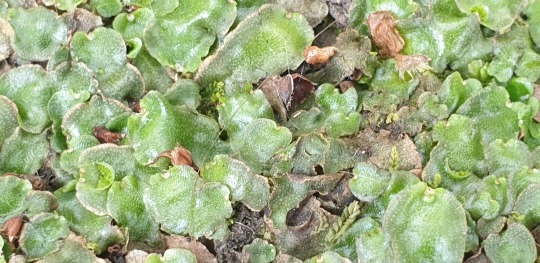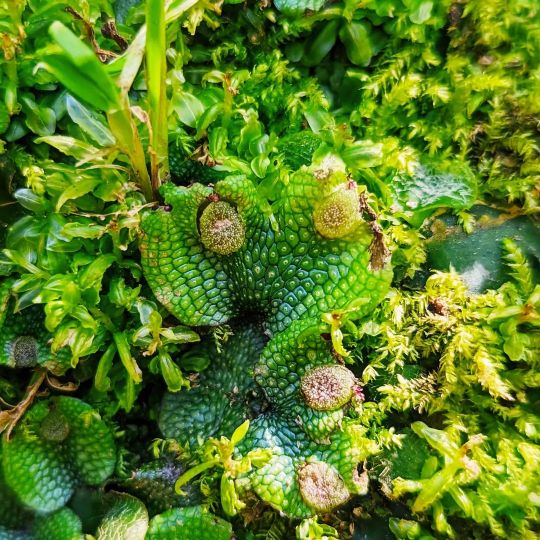#thallose liverwort
Photo

Liverworts (Marchantiophyta) are small, non-vascular plants with a fascinating lifecycle typical of the bryophytes, which include mosses and hornworts. Due to their small size and growth habit, these primitive beauties are often overlooked, but they’re actually quite common. I often find them growing in the “splash” zone of shady seeps and brooks, typically clinging to rock surfaces. There are two types of liverworts: thallose liverworts, whose scaly, flat surfaces branch out in a “Y” pattern; and leafy liverworts, which have overlapping, leaf-like scales arranged in at least two rows. The photo above is of snakeskin liverwort (Conocephalum salebrosum), a thallose liverwort I found growing in a seep along the Mon River Trail. As you might surmise, liverworts make dramatic show plants in terrariums, especially if you can get them to sprawl over a rock surface.
#appalachia#vandalia#west virginia#mon river trail#flora#non-vascular plants#bryophytes#marchantiophyta#liverworts#thallose liverwort#leafy liverwort#conocephalum salebrosum#snakeskin liverwort
104 notes
·
View notes
Text
#1877 - Lunularia cruciata - Crescent-cup Liverwort



Spotted growing around the irrigation sprinklers in the gardens of the Melbourne Immigration Museum. The only species in the genus Lunularia and family Lunulariaceae. As with the spleenworts, the common name is derived from their shape and imagined usefulness against liver complaints (often themselves imagined).
A robust and hardy thallose liverwort, common in shady damp spots in gardens. It resembles the better-known Marchantia, but in this liverwort the gemma cups are crescent-shaped rather than circular (hence 'lunularia'). Gemma cups contain modified clumps of tissue - gemmae - that can be splashed out by raindrops to become new plants. Probably originally native to Europe, and around the Mediteraanean, where the sexual forms (cross-shaped, hence 'cruciata') are most common. In other parts of the world, it relies more on asexual reproduction via gemmae.
Liverworts are typically small, with individual plants less than 10 cm long, but some species can cover large patches of ground, or whatever substrate they prefer. Most of the 9000 estimated species are found in humid locations although there are aquatic, desert and Arctic species. Some species are minor weeds in shady greenhouses or gardens.
4 notes
·
View notes
Photo

/Conocephalum conicum/ s.l., snakeskin liverwort, ジャゴケ Family Conocephalaceae Part two of our double-feature is easily one the most distinguishable liverworts. /C. conicum/ is a common species in the field and in gardens, and can cover large areas of the soil, if moist enough. The gametophyte body is flattened [botanical term: thallose], shiny and speckled with air pores that are separated by deep grooves*,**. /C. conicum/ is dioecious, with male plants developing antheridial pads (Fig.1) and female plants developing 6-7 lobed archegoniophores (Fig.2) at their apical ends. Unlike seed plants, C. conicum and other bryophytes produce flagellated sperm in their antheridia (the dark regions in the antheridial pads in Fig. 1). Rain and moisture disperse the sperm and allow them to access the female bits (archegonia in the lobes of Fig.2), where fertilization takes place. After fertilization, the stalk of the archegoniophore (possibly?!) gets raised*** as the zygote matures into the sporophyte (black tissues under the hood in Fig.3), a short-lived structure that is sort of the bryophyte's version of the flower. The sporophyte dries up in a controlled manner, and releases spores, both male and female, which will grow into new plants in the gametophyte generation! When not feeling frisky, /C. conicum/ gametophytes produce overwintering buds at their tips, which grow into new plants in the spring (Fig. 4) 👶. . . *Taxonomy note: Liverwort specialists, esp in Japan, tend to reassign plants with this specific feature to another species /C. salebrosum/ or /orientalis/ or /purpurubreum/ or /toyota/ or whatever I am tired (Fig. 5 maybe?). As a non-specialist, I have no way of telling the species of Conocephalum apart, so I just call them all by the old name /C. conicum/, 'sensu lato' (latin for 'in the broad sense') . **Math nerds: do you see the Voronoi pattern? . ***My hypothesis. I anguished over this photo, and clarification is very. much. welcome!!! . Photos taken at Sankeien, Yokohama and Mt. Yoshino, Nara . Useful reference: Akiyama 2022. Humans and Nature 32: 1−45. . . . #liverwort #bryophyte #spring #plants #plantlove #plantsofinstagram #botanize #japan https://www.instagram.com/p/Ch52D-thYWw/?igshid=NGJjMDIxMWI=
0 notes
Photo

Pellia epiphylla
Overleaf Pellia, Common Pellia
(via)
#Pellia epiphylla#Pellia#Overleaf Pellia#Common Pellia#liverworts#thallose liverworts#worts#green#dark green
11 notes
·
View notes
Photo

I've been excited for spring to arrive here, even if it is showing up worryingly early. To take my mind off of current worries, I drew up a coloring page with some of my favorite animals, plants and fungi that I get to see this time of year. You're welcome to print it off and color it yourself; enjoy!
Species portrayed: Red alder (Alnus rubra), western skunk cabbage (Lyschiton americanus), salal (Gaultheria shallon), yellowfoot (Craterellus lutescens), Pacific banana slug (Ariolimax columbianus), bonnets (Mycena sp.), Pacific tree frog (Pseudacris regilla), Oregon beaked moss (Kindbergia oregana), thallose liverwort (Marchanta polymorpha), Cascades torrent salamander (Rhyacotriton cascadae)
43 notes
·
View notes
Photo


Marchantia polymorpha - Thallose Liverwort
#marchantiophyta#marchanthia#marchantia polymorpha#thallose liverwort#stefano bonalume#bonalume#liverwort#plant#plants#flora#botany#green#soil#ground#palm#palms#moss#bryophyta#nature#country#countryside#meadow#grass#grassland#dead leaf
8 notes
·
View notes